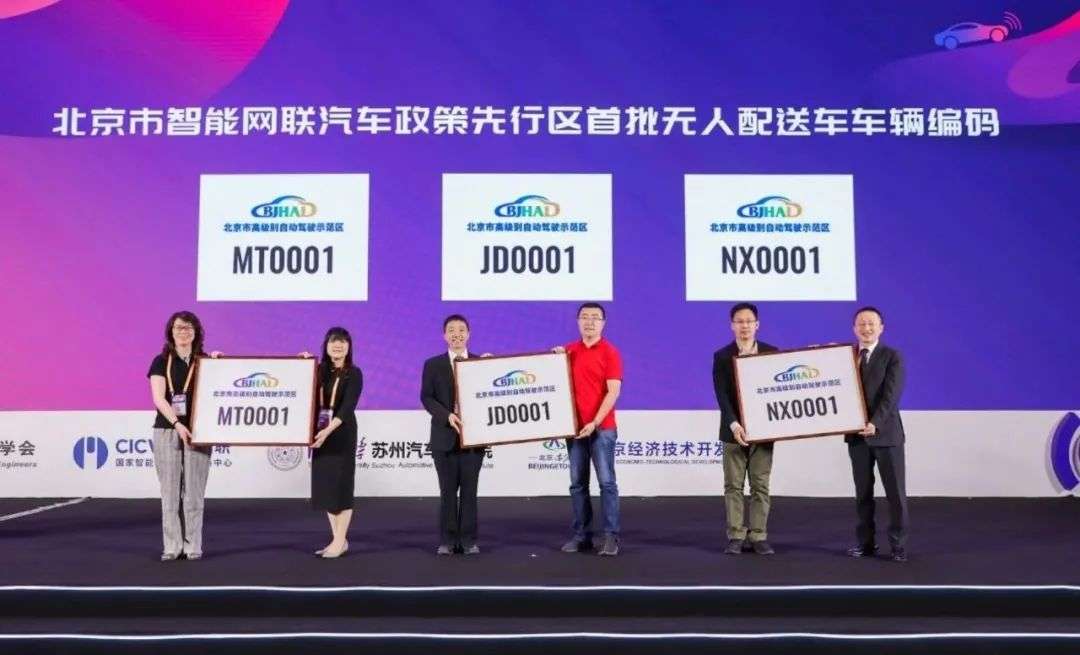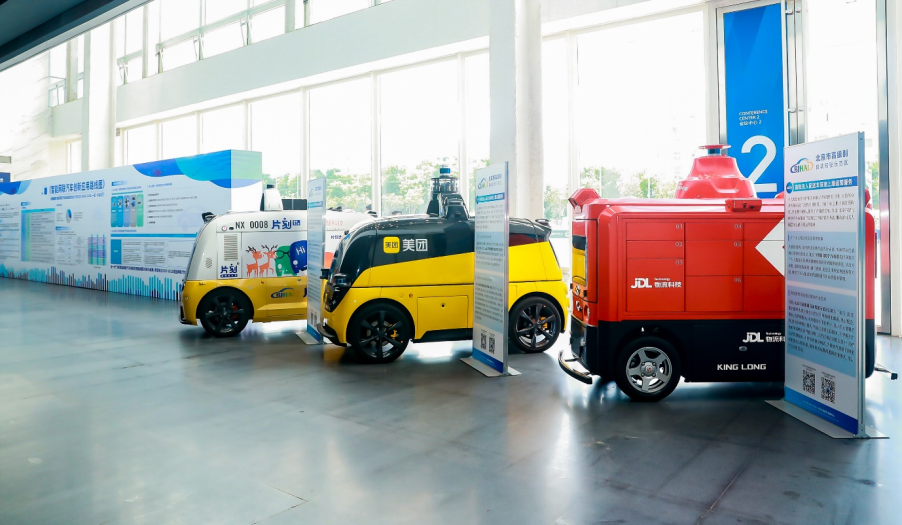The relevant policies for unmanned delivery vehicles on the roads in various provinces and cities in China may be released one after another.
Editor’s note: This article is from the WeChat public account “New Smart Drive” (ID: AI-Drive), author: Tian Zhe.
The relevant policies for unmanned delivery vehicles on the roads in various provinces and cities in China may be released one after another.
The commercialization of autonomous driving in China has taken another step forward.
Today, at the 8th International Intelligent Connected Vehicle Technology Annual Conference, Beijing’s high-level autonomous driving demonstration zone issued the first batch of domestic unmanned delivery vehicle vehicle codes, and for the first time gave the unmanned delivery vehicle the corresponding right of way.
Meituan, Jingdong, and Neolithic became the first batch of licensed companies, with vehicle codes MT0001, JD0001, and NX0001 respectively.
With the implementation of this policy, it means that these three companies are the first in China to achieve “certified work” for unmanned delivery vehicles.
Kong Qi, chief scientist of JD Logistics Autonomous Driving, said that the forward-looking management policies of the demonstration zone will bring more space and opportunities for the industrial development and technology implementation of unmanned delivery vehicles.
The first batch of on-road qualifications this time is a great affirmation for JD Logistics. Next, they can carry out larger-scale road tests and actual operations in the complex open road traffic environment to provide the public with intelligent delivery services , Accumulate experience for the iterative upgrade of technology.
“Future smart cities will be mobile, and mobility will bring unlimited possibilities,” Yu Enyuan, founder and CEO of Neolithic Autonomous Vehicles, also mentioned, “The first domestic unmanned vehicle road test license is granted to Neolithic Autonomous Vehicles. People and vehicles bring more room for development, not only can accumulate road test data to quickly iterate on autonomous driving technology, but also implement unmanned vehicle service networks to operate in multiple scenarios of open road connectivity and explore the’autonomous driving + N’mode to become a new smart city The development of new infrastructure.”
It is reported that JD.com and Meituan have invested nearly a hundred unmanned delivery vehicles in distribution stations, residential areas and industrial parks to develop terminalExpress delivery service.
Neolithic unmanned delivery vehicles have also been provided in Nanhaizi Park, Yicheng International, BDA Enterprise Avenue, Yongchang Industrial Park and other parks in the pilot zone, providing three meals a day.
Relevant policy details
Unmanned delivery vehicles are an important application of autonomous driving technology in the logistics field, which is of great significance for promoting the transformation and development of the express logistics industry from labor-intensive to technology-intensive.
Currently, there is no systematic management policy for unmanned delivery vehicles in various provinces and cities in China. As a whole, the company is still in the stage of testing in closed and semi-closed parks.
Beijing, as a pioneer area for domestic unmanned delivery vehicles to be compliant on the road, related policy formulation began in April this year.
On April 10 this year, Beijing relied on the high-level autonomous driving demonstration zone to set up the country’s first intelligent networked vehicle policy pilot zone. It is in this context that the new model of regulatory measures and implementation rules for the management of unmanned delivery vehicles should be issued.
Overall, Beijing’s unmanned delivery vehicle management policy has the following five innovation highlights:
The first is the general rules for innovating new products on the road.
Proactively explore the general rules applicable to unmanned delivery vehicles driving on the road, issue vehicle codes to enterprises that have passed the assessment, and conduct right of way management with reference to non-motor vehicle rules.
Specifically, unmanned delivery vehicles are prohibited from borrowing and overtaking under normal conditions; when the current vehicle and road conditions are abnormal, and not overtaking will hinder road traffic, unmanned delivery vehicles should borrow lanes under the premise of ensuring safety. Or overtake and return to the original lane after completion.
Under normal circumstances, the unmanned delivery vehicle is prohibited from reversing; in emergency situations such as the vehicle reversing or an accident, if the vehicle cannot continue without reversing, the vehicle should be reversed to a position where it can move forward under the premise of ensuring safety.
The second is to regulate the standards of vehicles on the road.
Standard specifications for the size, load, speed, power and other technical and testing indicators of unmanned delivery vehicles, and safety requirements in accordance with vehicle regulations, laying the foundation for the next development of unmanned delivery vehicles;
In terms of safety, unmanned delivery vehicles need to be equipped with various types of sensors, high-performance computing units, and have systems and equipment such as a redundant wire-controlled chassis and intelligent control software.
During driving, the speed of the unmanned delivery vehicle shall not exceed 15km/h;When the line of sight is limited, the unmanned delivery vehicle should alert pedestrians or vehicles through lights and sounds.
The third is to innovate business models.
Facing the future “unmanned economy”, explore and innovate the commercialization of new business forms, and innovate the management of unmanned sales.
Fourth is to innovate the safety supervision model.
For the first time, it is proposed that the driver of unmanned delivery vehicles should be classified and managed. It is required that on-site drivers and remote drivers must be equipped, and unmanned delivery vehicles must be included in the supervision of the autonomous driving supervision platform in the advance zone to achieve unified management of the platform.
In the early stage of operation of unmanned delivery vehicles, each unmanned delivery vehicle should be equipped with on-site drivers and remote drivers who have been trained by the company and have relevant technical knowledge to ensure the safe driving of unmanned delivery vehicles.
Fifth, actively explore new product insurance models.
For the first time, the requirements for insurance types, insurance coverage, and insured amounts for unmanned vehicles have been standardized to help the large-scale development of unmanned business models.
As a new form of road transportation participant, unmanned delivery vehicles have a wide range of application scenarios in many fields such as logistics distribution, retail, and security.
This time, after the release of the unmanned delivery vehicle management policy in the policy advance zone, it may solve the double gaps in the supervision and standards of such new products, spawn a large number of new unmanned economic formats, and greatly change the intelligent networked vehicles. Industrial ecological pattern.
The hot unmanned delivery track
In 2020, stimulated by the epidemic, the demand for unmanned delivery and market awareness will be greatly promoted, and the policy level will also be encouraged and supported by the central and local governments.
JD.com, Alibaba, Meituan, Great Wall Motors, etc. have all added to the unmanned delivery track. The American unmanned delivery startup Nuro has received a new round of US$500 million in financing. Domestic White Rhinoceros, Yiqing Innovation, and Uisee Technology Many start-up companies, such as Xingshen Intelligent, Zhixingzhe, Neolithic, and Yika Zhiche, have achieved new financing or business breakthroughs.
Unlike the Robotaxi track, the unmanned delivery head players at the end have removed the security guards and entered the normal operation, which has generated commercial value.
This means that the unmanned delivery vehicle has surpassed Robotaxi’s testing or open experience stage, and is further away from the true scale and commercialization.
JD, Alibaba, Meituan and other giant companies have stated that they plan to launch a thousand-unit unmanned delivery fleet in 2021, and plan to launch more than 10,000 vehicles in the next three years.
If the three Internet giants complete their goals, the world’s first unmanned fleet with over 1,000 units will be born on the unmanned delivery track this year, and the unmanned delivery track will be the first to usher in an outbreak in the next three years.
According to the existing express and takeaway order volume and growth trend forecast, the industry will usher in the huge challenge of delivering 1 billion orders per day in the next 5 years. Unmanned delivery vehicles will be the most cost-effective solution, and the total volume is expected to reach Millions of units,The market size will exceed 100 billion yuan.
If the spring of unmanned delivery vehicles has indeed appeared, the road to commercialization is actually not easy.
On April 3, 2018, the Ministry of Industry and Information Technology, the Ministry of Public Security, and the Ministry of Transport jointly issued a notice on “Management Specifications for Road Testing of Intelligent Connected Vehicles (Trial)”.
It mentioned: Unmanned delivery vehicles are not self-driving vehicles that can drive on roads and cannot drive on public roads.
Although the driving speed of the unmanned delivery vehicle is relatively low and the safety risk is relatively small, it essentially runs on open roads and needs to share the right of way with other vehicles.
In this case, how to divide the right of way and clarify the responsible party has become a thorny issue.
In response to this, Meituan, Baidu, JD.com, Cainiao and other business units jointly issued the “Proposal for Cultivating and Growing the Unmanned Delivery Industry” in March last year. Put forward an initiative.
In terms of laws and regulations, it is recommended to promote the classification of unmanned delivery vehicles, and to clarify related issues at the level of traffic laws, including issues such as the right of way, vehicle management rights, and responsible parties.
Today, as Meituan, JD.com, and Neolithic are the first companies in Beijing to obtain licenses for unmanned delivery vehicles, relevant policies for unmanned delivery vehicles on the roads in other provinces and cities in China may also be released one after another.


